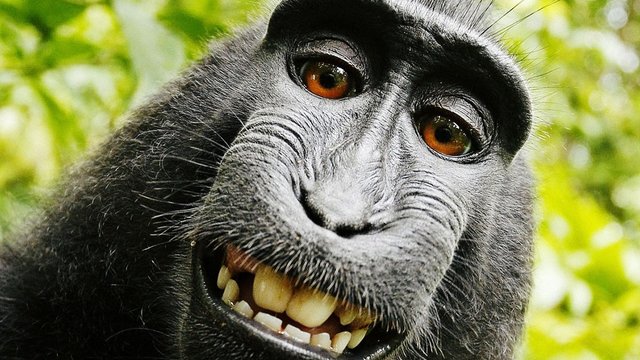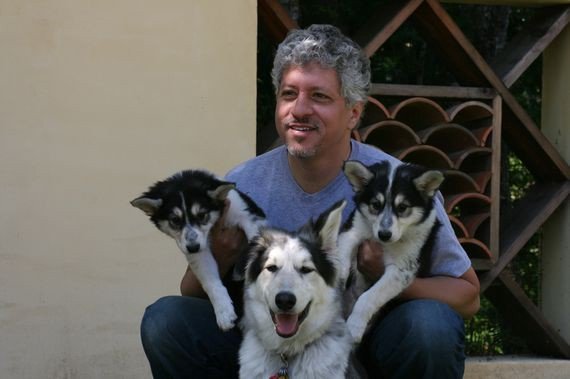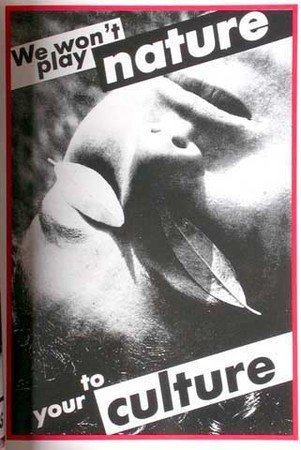The Role of Art in the Genomic Revolution.Bioethics, Video Games, and the Primacy of Nonhuman Animals

This ‘monkey selfie’ is the latest in an ongoing tradition of normative nature/culture breaches; as technology speeds forward, we will be forced to grapple with unprecedented and essential challenges to the lines we have drawn between ‘human’ and ‘animal
This month: PETA sued a photographer for claiming copyright on a selfie taken by a monkey. America’s most-hated pharma exec (and most artful troll) Martin Shkreli made a case for animal rights in the guise of refusing to stop meme-ing Harambe. An Israeli startup called SuperMeat has crowdfunded more than $160,000 for lab-grown chicken meat. Scientists have announced that dogs can understand what you’re saying to them (suprising to approximately no one with at least a shred of humility and a dog). And TechCrunch (rightfully) declared the microbiome a coming revolution in healthcare.
This last point, about the universe of nonhuman biological activity within your human body, is perhaps most indicative of the quiet revolution coming to healthcare, food, and your business. After all, only 10% of cells in the human body carry the human genome. The other 90% encode instructions for replicating bacteria, fungi, and other organisms now recognized as vital to our survival. (Seen through this lens, the entire era of antibiotics — though life-saving in many cases — can be considered a massive public health mistake.) So not only are humans not really that exceptional to begin with, we’re each actually only 10% human. And yet we continue unabated: destroying biodiversity, harming the biosphere, and generally acting “exceptional,” if not downright arrogant.

Cloned pets, the result of the Missyplicity Project
The seemingly unstoppable press of technology — and why should we stop it? — has led to William Gibson’s future: already here, just not yet evenly distributed. But without contemplating and addressing underlying ethical issues of equity, purpose, and directionality, we risk building a future plagued with the same issues of overconsumption, inequality, and ecological ruin that we’ve been facing in some form since the agricultural revolution. Who asks the hard questions: about what’s at stake in technological revolutions, about who benefits from new technologies while others fall behind, about when we are and where we’re headed? Pundits, policy-makers, and philosophers fall short. This is the task of art in the biotech revolution.
Its no mistake that over time, our dominant forms of media (mediums) are becoming more global and empathy-inducing. Most recently, avatars, augmented reality, and virtual reality have ushered in a promise to allow us to experience alternate realities, identities, and existences. This is especially important when grounded in a lived reality whose development of artificial intelligence, genetic modification, next-generation security apparatuses, and other consequential technologies speeds faster than our ability to understand.
Indeed, some of these topics have been explored in the art world for years. The traditions of BioArt and Hybrid Arts have long asked ethical questions about the genomic revolution, even as they existed at the leading edge of science. Take Oron Catts and Ionat Zurr, whose Tissue Culture & Art project, based at the University of Western Australia, “was set up to explore questions arising from the use of living tissues to create/grow semi-living objects/sculptures and to research the technologies involved in such a task.” Other projects, such as artist Kathy High’s “Embracing Animals,” ask more direct questions about our shifting relationship with nonhuman animals.
Ultimately, the distinction we make about the separation between humans and nonhumans is a false dichotomy. And yet it is incredibly fundamental to our civilization. Bruno Latour’s “great divides,” between nature/culture, human/nonhuman, living/machine, and subject/object are reified by a scientific obsession with purification and separation, conditions which notably cannot be recreated outside a lab. Hybridization is central to our lived experience, and central to the future we are building
The seemingly unstoppable press of technology — and why should we stop it? — has led to William Gibson’s future: already here, just not yet evenly distributed. But without contemplating and addressing underlying ethical issues of equity, purpose, and directionality, we risk building a future plagued with the same issues of overconsumption, inequality, and ecological ruin that we’ve been facing in some form since the agricultural revolution. Who asks the hard questions: about what’s at stake in technological revolutions, about who benefits from new technologies while others fall behind, about when we are and where we’re headed? Pundits, policy-makers, and philosophers fall short. This is the task of art in the biotech revolution.
Its no mistake that over time, our dominant forms of media (mediums) are becoming more global and empathy-inducing. Most recently, avatars, augmented reality, and virtual reality have ushered in a promise to allow us to experience alternate realities, identities, and existences. This is especially important when grounded in a lived reality whose development of artificial intelligence, genetic modification, next-generation security apparatuses, and other consequential technologies speeds faster than our ability to understand.
Indeed, some of these topics have been explored in the art world for years. The traditions of BioArt and Hybrid Arts have long asked ethical questions about the genomic revolution, even as they existed at the leading edge of science. Take Oron Catts and Ionat Zurr, whose Tissue Culture & Art project, based at the University of Western Australia, “was set up to explore questions arising from the use of living tissues to create/grow semi-living objects/sculptures and to research the technologies involved in such a task.” Other projects, such as artist Kathy High’s “Embracing Animals,” ask more direct questions about our shifting relationship with nonhuman animals.
Ultimately, the distinction we make about the separation between humans and nonhumans is a false dichotomy. And yet it is incredibly fundamental to our civilization. Bruno Latour’s “great divides,” between nature/culture, human/nonhuman, living/machine, and subject/object are reified by a scientific obsession with purification and separation, conditions which notably cannot be recreated outside a lab. Hybridization is central to our lived experience, and central to the future we are building.

Barbara Kruger’s art asked questions about identity and hybrid forms
Since we will quite likely be cloning people and building brains before we understand matters of consciousness and spirit, art is — perhaps ironically — our most proactive, productive, pragmatic, and prudent avenue through which to explore the ethical aspects of new technologies and new hybrid forms. Specifically, video games and VR experiences will be (and in some cases, already are) how we publicly imagine these technologies and predict their consequences, and thus will shape how we plan their implementation.
Video games, which during the digital revolution were largely considered dangerous, addictive, superfluous, and time-wasting, are now recognized to aid critical thinking, strategy, teamwork, and the development of complex decision-making skills. The potential of their direct use in education and training is just beginning to be explored at the federal level.
Commercial games, which already artistically and pragmatically explore bioweaponry, nuclear fallout, counterterrorism, future warfare, biological evolution, space exploration, and more, will likewise (in some cases simultaneously) help us imagine the future of genetic modification, smart city living, biometric security, climate change mitigation, extra-planetary resource extraction and settlement, and more.
A note of caution: what gets imagined gets created, for better or worse. It’s why we can’t stop driving toward the security apparatuses envisioned in Minority Report and 1984, even though we might not be attracted to the ethical quandaries explored therein. But without artistic exploration of present-and-future implications of things like lab-grown meat, animal intellectual property, and CRISPR cas-9, as a society we are truly at the mercy of commercial R&D.
As I wrote in my undergrad anthropological thesis, which asked questions about what’s at stake in the animal biotech revolution, the project that remains is perhaps not to predict but to plan the future — to prepare for a reassembly of the social and the emergence of novel forms of social organization. Perhaps the real hubris lies in exercising increasing control over the world around us while denying that it is a part of us, that we are a part of it, and that we have any say in its future. Rather than expend energy and resources on self-flagellation by way of extant ecological discourses, we must rather embrace the emerging hybrids of our crisis of novelty.
As nonhuman animals begin to resemble nonhuman machines and vice versa, we need to reconsider not animals and machines, but rather the distinction we make between them and further the wall we have built between ‘them’ and ‘us.’ Perhaps true humanity lies in the crossover.
There is a future, and it does differ from the past. But where once it was a matter of hundreds and thousands, now millions and billions have to be accommodated — billions of people, of course, but also billions of animals, stars, prions, cows, robots, chips, and bytes…
Instead of two powers, one hidden and indisputable (nature), and the other disputable and despised (politics), we will have two different tasks in the same collective.
The first task will be to answer the question: How many humans and nonhumans are to be taken into account?
The second will be to answer the most difficult of all questions: Are you ready, and at the price of what sacrifice, to live the good life together?
Source:https://medium.com/art-marketing/the-role-of-art-in-the-genomic-revolution-c0708070816#.m0haz0lnx